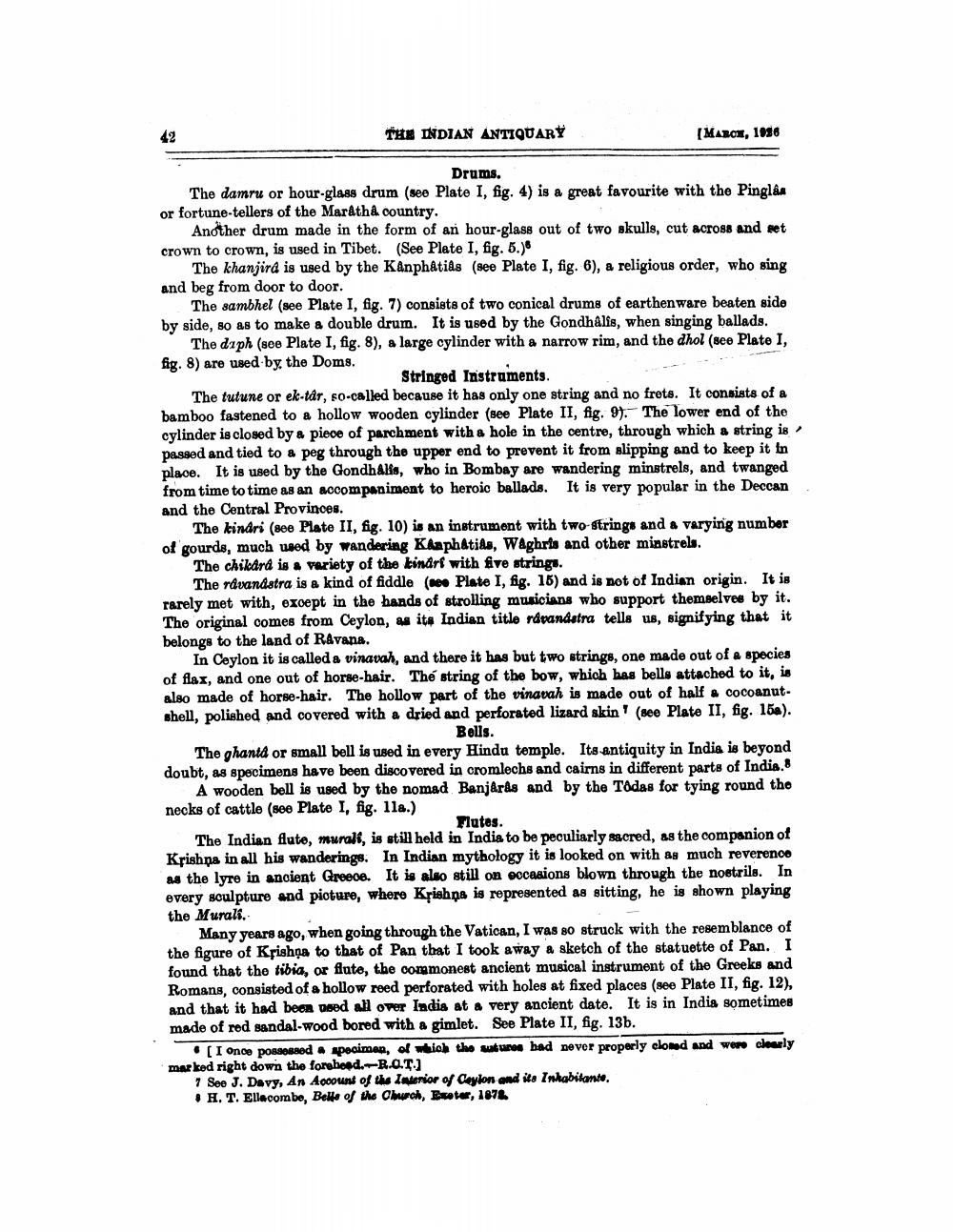________________
THE INDIAN ANTIQUARY
[MABOM, 1996
Drums. The damru or hour-glass drum (see Plate I, fig. 4) is a great favourite with the Pinglês or fortune-tellers of the Marath & country.
Another drum made in the form of an hour-glass out of two skulls, cut across and set crown to crown, is used in Tibet. (See Plate I, fig. 5.)
The khanjird is used by the Kånphatias (see Plate I, fig. 6), a religious order, who sing and beg from door to door.
The sambhel (see Plate I, fig. 7) consists of two conical drums of earthenware beaten side by side, so as to make a double drum. It is used by the Gondhalis, when singing ballads.
The diph (see Plate I, fig. 8), a large cylinder with a narrow rim, and the dhol (see Plate I, fig. 8) are used by the Doms.
Stringed Instruments. The tutune or ek-tár, so-called because it has only one string and no frets. It consists of a bamboo fastened to a hollow wooden cylinder (see Plate II, fig. 9). The lower end of the cylinder is closed by a piece of parchment with a hole in the centre, through which a string is passed and tied to a peg through the upper end to prevent it from slipping and to keep it in place. It is used by the Gondhals, who in Bombay are wandering minstrels, and twanged from time to time as an accompaniment to heroic ballads. It is very popular in the Deccan and the Central Provinces.
The kindri (see Plate II, fig. 10) is an instrument with two-strings and a varying number of courds, much wed by wandering Klaphátias, Waghris and other minstrels.
The chikard is a variety of the kindrf with five strings.
The rdvandstra is a kind of fiddle (new Plate I, fig. 15) and is not of Indian origin. It is rarely met with, except in the hands of strolling musicians who support themselves by it. The original comes from Ceylon, with Indian title råvandstra tells us, signifying that it belongs to the land of RAvana.
In Ceylon it is called a vinavah, and there it has but two strings, one made out of a species of flax, and one out of horse-hair. The string of the bow, which has bells attached to it, is also made of horse-hair. The hollow part of the vinavah is made out of half a cocoanut. shell, polished and covered with a dried and perforated lizard skin' (see Plate II, fig. 158).
Bells. The ghantà or small bell is used in every Hindu temple. Its antiquity in India is beyond doubt, as specimens have been discovered in cromlechs and cairns in different parts of India.8
A wooden bell is used by the nomad Banjárds and by the Todas for tying round the necks of cattle (see Plate I, fig. lla.)
Flutes. The Indian flute, murali, is still held in India to be peculiarly sacred, as the companion of Krishna in all his wanderings. In Indian mythology it is looked on with as much reverence as the lyre in ancient Greece. It is also still on pocasions blown through the nostrils. In every sculpture and picture, where Krishna is represented as sitting, he is shown playing the Murali.
Many years ago, when going through the Vatican, I was so struck with the resemblance of the figure of Krishqa to that of Pan that I took away a sketch of the statuette of Pan. I found that the tibia, or flute, the commonest ancient musical instrument of the Greeks and Romans, consisted of a hollow reed perforated with holes at fixed places (see Plate II, fig. 12), and that it had been used all over India at a very ancient date. It is in India sometimes made of red sandal-wood bored with a gimlet. See Plate II, fig. 13b.
. [I once possessed specimen, of which the sutures had never properly cloned and were clearly marked right down the forghord.R.O.T.)
7 Seo J. Davy, An Account of the Interior of Ceylon and its Inhabitante, # H. T. Ellecombe, Belte of the Church, Ester, 1874




